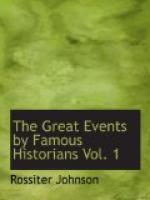Such, as the National Alumni regard it, are the general character, wide scope, and earnest purpose of THE GREAT EVENTS BY FAMOUS HISTORIANS. Let us end by saying, in the friendly fashion of the old days when bookmakers and their readers were more intimate than now: “Kind reader, if this our performance doth in aught fall short of promise, blame not our good intent, but our unperfect wit.”
THE NATIONAL ALUMNI.
AN OUTLINE NARRATIVE
TRACING BRIEFLY THE CAUSES, CONNECTIONS, AND CONSEQUENCES OF
THE GREAT EVENTS
A GENERAL SURVEY OF THE PROGRESS OF THE HUMAN RACE,
ITS ADVANCE IN
KNOWLEDGE AND CIVILIZATION, AND THE BROAD WORLD MOVEMENTS
WHICH HAVE
SHAPED ITS DESTINY
CHARLES F. HORNE, Ph.D.
CONTINUED THROUGH THE SUCCESSIVE VOLUMES AND COVERING
THE SUCCESSIVE
PERIODS OF
THE GREAT EVENTS BY FAMOUS HISTORIANS
AN OUTLINE NARRATIVE
TRACING BRIEFLY THE CAUSES, CONNECTIONS, AND CONSEQUENCES OF
THE GREAT EVENTS
(FROM THE BEGINNING TO THE OVERTHROW OF THE PERSIANS)
CHARLES F. HORNE
History, if we define it as the mere transcription of the written records of former generations, can go no farther back than the time such records were first made, no farther than the art of writing. But now that we have come to recognize the great earth itself as a story-book, as a keeper of records buried one beneath the other, confused and half obliterated, yet not wholly beyond our comprehension, now the historian may fairly be allowed to speak of a far earlier day.
For unmeasured and immeasurable centuries man lived on earth a creature so little removed from “the beasts that die,” so little superior to them, that he has left no clearer record than they of his presence here. From the dry bones of an extinct mammoth or a plesiosaur, Cuvier reconstructed the entire animal and described its habits and its home. So, too, looking on an ancient, strange, scarce human skull, dug from the deeper strata beneath our feet, anatomists tell us that the owner was a man indeed, but one little better than an ape. A few aeons later this creature leaves among his bones chipped flints that narrow to a point; and the archaeologist, taking up the tale, explains that man has become tool-using, he has become intelligent beyond all the other animals of earth. Physically he is but a mite amid the beast monsters that surround him, but by value of his brain he conquers them. He has begun his career of mastery.
If we delve amid more recent strata, we find the flint weapons have become bronze. Their owner has learned to handle a ductile metal, to draw it from the rocks and fuse it in the fire. Later still he has discovered how to melt the harder and more useful iron. We say roughly, therefore, that man passed through a stone age, a bronze age, and then an iron age.




